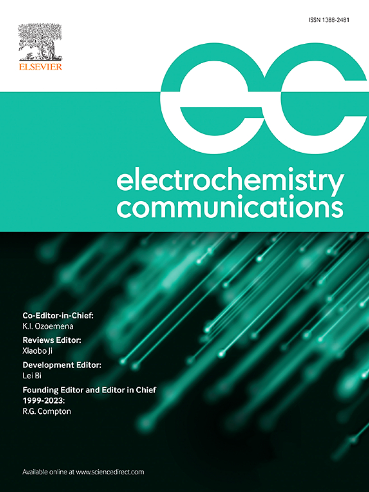Effect of solvent type on solution synthesis of Na3V2(PO4)3/C cathode material for Na storage
IF 4.2
3区 工程技术
Q2 ELECTROCHEMISTRY
引用次数: 0
Abstract
Na3V2(PO4)3/C powders were prepared using a solution technique with cetyltrimethylammonium bromide (CTAB) in various solvents, including ethanol, methanol, and glycerol. The impact of the solvent choice on the structural, microstructural, and electrochemical properties was elucidated by X-ray diffractometry, Raman spectroscopy, electron microscopy, galvanostatic charge-discharge, and electrochemical impedance spectroscopy methods. Single-phase Na3V2(PO4)3 (NVP) powders were achieved by calcining at 850 °C for 6 h, irrespective of the solvent type. Decomposition of the CTAB agent resulted in a carbon layer over the nearly spherical NVP particles. The methanol solvent revealed a finer particle size, leading to superior electrochemical performance, such as a capacity retention of 82 % after 50 cycles at a 1C current rate and a rate capability of 71.63 % when increasing the current rate from 0.1C to 1C. The superior quality carbon layer on the NVP particles, achieved by the methanol solvent, played a key role in the enhanced electrochemical performance.
溶剂类型对Na存储用Na3V2(PO4)3/C正极材料溶液合成的影响
采用十六烷基三甲基溴化铵(CTAB)溶液法,在乙醇、甲醇、甘油等溶剂中制备了Na3V2(PO4)3/C粉末。通过x射线衍射、拉曼光谱、电子显微镜、恒流充放电和电化学阻抗等方法分析了溶剂选择对结构、微观结构和电化学性能的影响。无论溶剂类型如何,均可在850℃下煅烧6h得到单相Na3V2(PO4)3 (NVP)粉末。CTAB试剂的分解导致近球形NVP颗粒上的碳层。在1C电流下循环50次后,其容量保持率为82%,当电流从0.1C增加到1C时,其容量保持率为71.63%。甲醇溶剂在NVP颗粒上形成的优质碳层对提高电化学性能起着关键作用。
本文章由计算机程序翻译,如有差异,请以英文原文为准。
求助全文
约1分钟内获得全文
求助全文
来源期刊

Electrochemistry Communications
工程技术-电化学
CiteScore
8.50
自引率
3.70%
发文量
160
审稿时长
1.2 months
期刊介绍:
Electrochemistry Communications is an open access journal providing fast dissemination of short communications, full communications and mini reviews covering the whole field of electrochemistry which merit urgent publication. Short communications are limited to a maximum of 20,000 characters (including spaces) while full communications and mini reviews are limited to 25,000 characters (including spaces). Supplementary information is permitted for full communications and mini reviews but not for short communications. We aim to be the fastest journal in electrochemistry for these types of papers.
 求助内容:
求助内容: 应助结果提醒方式:
应助结果提醒方式:


